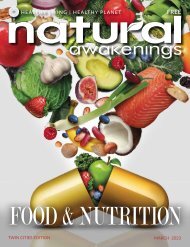Natural Awakenings Twin Cities March 2022
Read the March 2022 edition of Natural Awakenings Twin Cities magazine. This is our annual Food and Nutrition Issue which is focused on plant-based foods, supporting local farmer's market and beyond picky eating; help for pediatric eating disorders. This month we feature articles on myofascial release for oral health, tips on making one's presence on Facebook, plant-based foods go mainstream, geopathic stress in your garden that affects the growth of your plants, bounty of the farmer's market and so much more! Be sure to check out our local content including News Briefs announcements, Community Resource Guide with providers throughout the metro who can meet your individual wellness needs, and all the happenings in the Calendar of Events. There is additional online-only content that can be found at NATwinCities.com.
Read the March 2022 edition of Natural Awakenings Twin Cities magazine. This is our annual Food and Nutrition Issue which is focused on plant-based foods, supporting local farmer's market and beyond picky eating; help for pediatric eating disorders. This month we feature articles on myofascial release for oral health, tips on making one's presence on Facebook, plant-based foods go mainstream, geopathic stress in your garden that affects the growth of your plants, bounty of the farmer's market and so much more!
Be sure to check out our local content including News Briefs announcements, Community Resource Guide with providers throughout the metro who can meet your individual wellness needs, and all the happenings in the Calendar of Events. There is additional online-only content that can be found at NATwinCities.com.
You also want an ePaper? Increase the reach of your titles
YUMPU automatically turns print PDFs into web optimized ePapers that Google loves.
program, says, “It is important for parents to know that the main<br />
risk factor for developing an eating disorder is genetic. This means<br />
some children are genetically at risk and others are not.”<br />
The fires of predisposition can be fueled by “body dissatisfaction,<br />
dieting and involvement in activities that favor thinness,<br />
such as dance, gymnastics and running,” says Herrin, adding that<br />
the disorder defies stereotypes. “Because a child is male or has always<br />
been on the heavier side doesn’t mean that child is immune<br />
from developing an eating disorder.”<br />
Being repelled by foods with certain colors, tastes, textures or<br />
smells and having phobias around vomiting or choking are often<br />
catalysts to disorders. “Extreme picky eating that leads to restricting<br />
food intake is now considered an eating disorder in its own<br />
right, called avoidant/restrictive food intake disorder (ARFID),”<br />
says Herrin. “The main difference between the child restricting<br />
food intake because of anorexia nervosa and the child with<br />
ARFID is that those with ARFID don’t care about weight or have<br />
body image issues.”<br />
For Cassandra Lenza, an eating disorder therapist and the<br />
owner of Healing on Hudson, in Hoboken, New Jersey, the lasting<br />
imprints of a pervasive “diet culture” cannot be ignored. “The<br />
main and persistent risk factor for the development of eating<br />
disorders is early dieting,” she says. “Children under 12 who<br />
are dieting or exposed to dieting in their environment are more<br />
susceptible to the development of eating disorders than children<br />
who are not.” It is imperative, she says, that parents model healthy<br />
eating and provide a child with the tools for success.<br />
A Whole-Child Approach<br />
Cognitive behavioral therapy, mindfulness training and yoga have<br />
been shown in studies to help both children and adults to process<br />
critical emotions, thoughts and eating patterns. Lenza attests to<br />
the effectiveness of holistic, multidisciplined care for reversing the<br />
common effects of eating disorders like exhaustion and gastrointestinal,<br />
hormonal or cognitive impairment. “We recommend a<br />
three-pronged treatment approach for all children which includes<br />
working with a therapist who treats eating disorder behavior, a<br />
registered dietitian who can help nutritionally and a pediatrician<br />
who can monitor the child medically,” she says.<br />
Habits and bonds within the family unit go a long way toward<br />
prevention. “Having a family dinner most days of the week<br />
substantially reduces the risk of a child developing an eating<br />
disorder,” says Herrin. For recovery, she advises, “The most effective<br />
treatment for children up to age 19 is family-based treatment<br />
(FBT). In FBT, clinicians show parents how to help their child eat<br />
enough to restore health. The type of eating that is most effective<br />
is good old-fashioned meals with plenty of calories from carbs, fat<br />
and protein.”<br />
With observant parents and quality care, children have a<br />
brighter future. “The early signs are often subtle,” counsels Herrin.<br />
“Trust your intuition.”<br />
Marlaina Donato is an author and composer. Connect at<br />
WildflowerLady.com.<br />
Kids’ Eating Disorders<br />
Some common disorders in children 12 and under include:<br />
ANOREXIA NERVOSA: Signs and symptoms include<br />
weight loss (often dramatic), distorted body image, intense<br />
anxiety/fear of weight gain and other behaviors that prevent<br />
weight gain.<br />
AVOIDANT/RESTRICTIVE FOOD INTAKE<br />
DISORDER (ARFID): Signs and symptoms include extreme<br />
pickiness; lack of interest in food without body dissatisfaction;<br />
aversion to specific tastes, smells, texture and appearance<br />
of foods; avoidance of certain foods/food groups or habitual<br />
eating of only a few foods; fear of swallowing; anxiety about<br />
getting bellyaches or getting sick; weight loss and/or stunted<br />
growth from insufficient nourishment and malnutrition.<br />
PICA: Signs and symptoms include eating non-edible substances<br />
such as crayons, paper, grass, rocks, feces, hair, paint<br />
chips, cleaning powders or clay; health problems such as constipation<br />
or diarrhea, intestinal obstruction or infection, anemia<br />
or lead poisoning. It is often seen in children on the autism<br />
spectrum that have a history of abuse or neglect, or mental<br />
health conditions like schizophrenia, anxiety or obsessivecompulsive<br />
disorder. It can also be caused by a zinc deficiency.<br />
SUBTLE WARNING SIGNS FROM<br />
CASSANDRA LENZA INCLUDE:<br />
n Child discussing dieting, food obsessions or weightcontrol<br />
measures; discussing exercise with greater<br />
interest, especially if she/he has not discussed exercise<br />
or movement before<br />
n Social confinement and isolation<br />
n Increased body dissatisfaction<br />
n Changes on child’s growth chart<br />
Other signs: delayed puberty, eating smaller food portions,<br />
weight changes, thinning hair, hiding food, digestive problems,<br />
downy hair growth on body, severe mood swings or<br />
tantrums, excessive movement<br />
TIPS FOR PARENTS FROM<br />
MARCIA HERRIN INCLUDE:<br />
n Avoid labeling food as good<br />
or bad. It is better to serve all<br />
kinds of foods in moderation.<br />
n Avoid talking about dieting,<br />
weight or judgments about<br />
different body types or sizes.<br />
n Never tease a<br />
child about<br />
their weight or<br />
changing body.<br />
JessBaileyDesigns /Pexels.com<br />
<strong>March</strong> <strong>2022</strong><br />
25

















